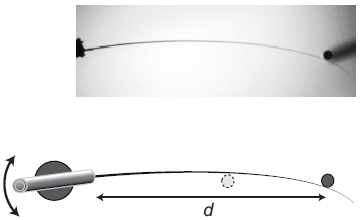Why rodents have cone-shaped whiskers...
Interview with
Conical whiskers allow mammals that live in tunnels and other enclosed spaces to learn more about  their surroundings.
their surroundings.
Andrew - With mice, they have many whiskers and their sense of touch to their whiskers is vitally important for them to navigate their environment and to discover and identify objects around them. And these whiskers actually, have a very special shape. They're almost perfect cones, and this actually gives them a lot of advantages for the natural environment in which a mouse might find himself in.
Chris - So, what are the big unknowns then about these whiskers that you were trying to flush out?
Andrew - We really wanted to understand why is it that these whiskers are conically-shaped because all mammals have whiskers. There were other whiskers in other species that have different shapes like a flattened shape, or bulging shapes. So, what is special about the conical shape of the mouse whisker that is adaptive for the environment which mice live in?
Chris - Things like burrows, and holes, and sewers. So, how did you go about actually trying to model or test that?
Andrew - As a scientist, the first thing you want to do is go the reductionist approach in which we take a whisker out of the mouse. Mount it on a little stick and then rotate it into objects at various distances. And when we observed how the whisker changed shape, based on how far away it is from an object, how hard we're pushing into the object. And what we observed is that when the conical whisker is moving into an object or being pushed past an object, there is a critical moment in which the whisker just slips past the object. It's not when the whisker reaches the very tip end. Actually, it's much sooner and we thought that that was kind of a surprise. And so, looking into the mathematics of how that took place, my collaborator David Golomb, realised that the precise point in which the whisker slips off an object is actually related to this conical shape.
Chris - Does it matter how far down the whisker that contact occurs before the slippage begins to occur?
Andrew - Absolutely. So, since whiskers are much more flexible at the tip than at the base, when you're contacting an object near the tip of the whisker, slip offs occur much more easily. You don't have to move the whisker very far before slip off occurs. Now, if contacting near the base, then you really have to rotate the whisker. The whisker has to move a long way into the object before it suddenly slips past.
Chris - So, do these measurements by physically mounting a whisker and then pushing it into things, is that actually what the mice do?
Andrew - So, what mice do is that it scamper up to an object and then they start moving their whiskers backwards and forwards very rapidly, then they orient their face so that they sweep their whiskers backwards and forwards across an object, that's called whisking. And over the course of moving their whiskers back and forth multiple times, they build up a sort of understanding of what the object is, its position, its texture, and use this to identify and localise the object.
Chris - So, do you think then that given what you've discovered about the importance of this conical profile, that we could use this in making better sensors for us rather than just for mice?
Andrew - This is just one interesting avenue of future research. If you look at any blind person that's walking down the street, often times they have these white canes that are going backwards and forwards, tapping left and right, left and right. And they can try to find out the distance to objects by striking them with their cane, and one critical thing I did when researching white cane travel, is I've read some people complain that, for example, a three-part white cane assembled in sections, lacks the same flexibility as a single uniform cane that has a taper to it. And I think that the same mechanisms are in play with blind people who are using white canes to navigate their environment and identify objects. So, it would be nice to see if we can now apply the principles that we've discovered from the mouse whisker system to improve the design of white canes, perhaps with tips that have a greater flexibility gradient from base to tip.
- Previous Dehydrate to survive!
- Next Cortical plasticity: how brains adapt









Comments
Add a comment